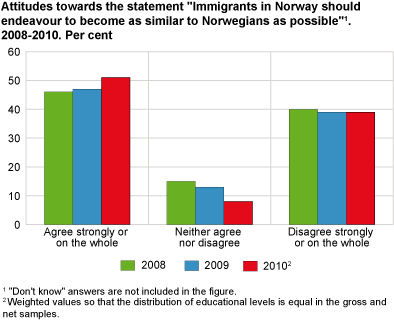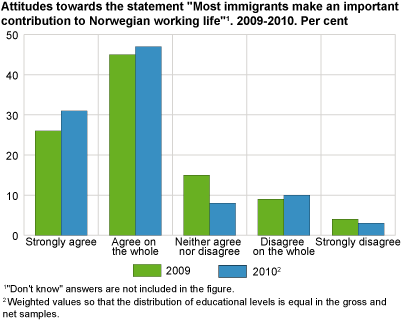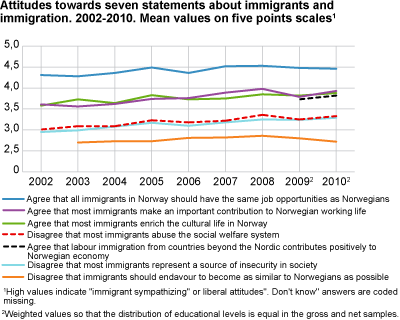Content
Published:
This is an archived release.
Appreciate immigrants’ contribution to working life
Three out of four think that immigrants make an important contribution to Norwegian working life. This is the highest proportion ever recorded. Only 13 per cent hold the opposite opinion.
The proportion agreeing strongly or on the whole that “Most immigrants make an important contribution to Norwegian working life” increased by 6 percentage points compared to the same period in 2009. In the present survey, a full 77 per cent agree strongly or on the whole with this statement, while only 13 per cent disagree.
This is the highest recorded proportion of respondents agreeing. Last year saw a decrease in the proportion agreeing of 4 percentage points, probably due to feelings of insecurity in the wake of the financial crisis. Even though the unemployment rate has not fallen from last year, there is now a growing belief that the country is likely to overcome the financial crisis without too serious repercussions. This might explain the change in attitudes.
There is also a smaller increase in the proportion agreeing that “Labour immigration from non-Nordic countries makes a mainly positive contribution to the Norwegian economy” . Seventy per cent agree with this, whereas 15 per cent disagree. Comparative figures for 2009 were 68 and 14 per cent respectively. The survey on attitudes towards immigrants and immigration was conducted by Statistics Norway in July/August 2010.
Increased support for assimilation
During the last two years the assertion that “Immigrants in Norway should endeavour to become as similar to Norwegians as possible” has gained support. Fifty-one per cent agreed with this in 2010, compared with 46 per cent in 2008. It may be an expression of the population’s reaction to attitudes in some immigrant communities that could be interpreted as a challenge to values such as gender equality and freedom of speech.
The majority rejects that the social welfare system is being abused
The results of the survey also show that 88 per cent think that immigrants in Norway should have the same job opportunities as Norwegians. Only 7 per cent disagree with this. Thirty-one per cent agree that “Most immigrants abuse the social welfare system” and 36 per cent agree that “Most immigrants represent a source of insecurity in society” . The majority, however, rejects these statements; 53 and 54 per cent respectively. This is roughly the same as in last year’s survey.
No softening attitudes regarding refugee policy
More than 90 per cent deny that they would feel uncomfortable if they or someone in their closest family had an immigrant as a domestic help or if their neighbour was an immigrant. One out of four, however, thinks they would feel uncomfortable if their son or daughter wanted to marry an immigrant. Furthermore, 46 per cent think it should be more difficult for refugees and asylum seekers to obtain a residence permit in Norway “compared to today”, whereas 42 per cent think that the access to permits should remain unchanged. The attitudes here are also roughly the same as last year, in spite of reduced numbers of asylum seekers.
The age group 45-66 tends to be more benevolent
The population’s attitudes to immigrants and immigration vary according to background factors such as gender, age, educational level, place of residence etc. Women are often more tolerant than men, while the most elderly (67-79 years) are the most sceptical. We also see that the age group next to the oldest (45-66 years) tends to move in a more benevolent direction than before. Higher education is also associated with increased tolerance. Residents of the most urban regions and in the Akershus/Oslo area are generally more generous towards immigrants and immigration than those residing in other parts of the country. Persons who have contact with immigrants also have more positive attitudes towards immigrants and immigration than people without this kind of contact.
Tables:
- Table 1 Attitudes towards seven statements on immigrants and immigration, 2002- 2009. Per cent
- Table 2 Attitudes towards the statement "All immigrants in Norway should have the same job opportunities as Norwegians". 1993-2000 and 2002-2010. Per cent
- Table 3 Attitudes towards refugees' and asylum seekers' access to residence permits in Norway. Compared to today, should it be easier, more difficult or remain the same as today. 2002-2010. Per cent
- Table 4 Answers to three questions on relations to immigrants. 2002-2010. Per cent
- Table 5 Contact with immigrants in different arenas. 2002-2010. Per cent
- Table 6 Number of arenas where contact with immigrants takes place. 2002-2010. Per cent
- Table 7 Number of immigrants one has contact with. 2003-2010. Per cent
- Table 8 How often one has contact with immigrants, normally. 2003, 2007-2010. Per cent
- Table 9 Personal experience with the contact with immigrants. 2003, 2007-2010. Per cent
Contact
-
Frøydis Strøm
E-mail: froydis.strom@ssb.no
tel.: (+47) 40 81 13 17
-
Christian Sørlien Molstad
E-mail: christian.molstad@ssb.no
tel.: (+47) 46 65 99 12



